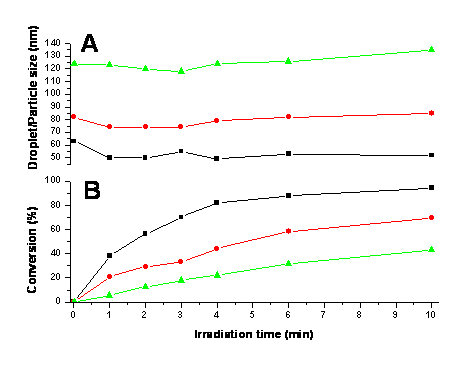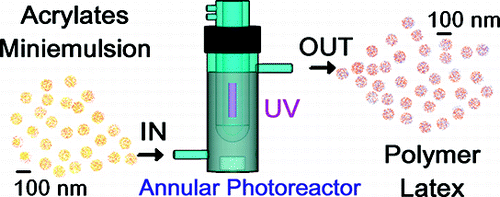Photo-induced Polymerization in dispersed media
Photoinduced Miniemulsion Polymerization
 Conventional free-radical polymerization in a dispersed medium is currently conducted on a large scale by industry and offers many advantages. This process leads to a stable dispersion of polymer particles in a liquid medium, usually water. A vast majority of the studies on emulsion polymerization processes focus primarily on thermally-initiated polymerization. Nevertheless, there have been a few examples of photoinduced polymerization in aqueous dispersed medium since the 80s, mainly relying on microemulsion or micellar [polymerizations, with some minor contributions from emulsion, dispersion, miniemulsion and suspension polymerizations . Monomer microemulsions and micellar systems are thermodynamically stable and form spontaneously with an appropriate combination of a surfactant and a costabilizer. Their low droplet size in the tenth nanometer size range (10-50 nm) affording optical transparency in the UV-visible region, makes them particularly suitable for photochemical reactions.
Conventional free-radical polymerization in a dispersed medium is currently conducted on a large scale by industry and offers many advantages. This process leads to a stable dispersion of polymer particles in a liquid medium, usually water. A vast majority of the studies on emulsion polymerization processes focus primarily on thermally-initiated polymerization. Nevertheless, there have been a few examples of photoinduced polymerization in aqueous dispersed medium since the 80s, mainly relying on microemulsion or micellar [polymerizations, with some minor contributions from emulsion, dispersion, miniemulsion and suspension polymerizations . Monomer microemulsions and micellar systems are thermodynamically stable and form spontaneously with an appropriate combination of a surfactant and a costabilizer. Their low droplet size in the tenth nanometer size range (10-50 nm) affording optical transparency in the UV-visible region, makes them particularly suitable for photochemical reactions.
The present approach is very different since conventional free radical photopolymerization in miniemulsion was investigated with a formulation including simply conventional acrylate monomers (butyl acrylate, methyl methacrylate, acrylic acid) and a commercial type I radical photoinitiatiors (BAPO). The formation of nanosized acrylate droplets encapsulating this hydrophobic photoinitiator was first achieved by sonication. UV irradiation was subsequently applied to the monomer miniemulsion, to produce quantitatively at high rates polymer nanoparticles of similar size. The present study deals with the kinetics aspects of this reaction and the colloidal properties of the resulting polymer dispersions. In particular, the influence of the monomer composition, the nature of the radical photoinitiatiator and the organic phase content are some of the experimental parameters that will be investigated in details. Additionally, the use of a photoinduced technique opens up new prospects for the characterization of the miniemulsion polymerization. Thus, real-time Fourier transform near-infrared spectroscopy (RT-FTNIR) was for the first time implemented to follow continuously the progress of the radical photopolymerization. We also attempted to measure the evolution of the miniemulsion size throughout the UV irradiation by the use of dynamic light scattering (DLS).
Contact: Celine Croutxe-Barghorn
Publication: Colloid and Polymer Science, accepted
Radical Photopolymerization in Miniemulsions. Fundamental Investigations and Technical Development

A photochemical means to convert acrylate monomer emulsions into polymer nanolatexes has been explored using radical miniemulsion photopolymerization. Our aim is to offer a complete overview through a stepwise mechanistic investigation, addressing first the key aspect of the electronic excitation of the photoinitiator in monomer miniemulsions and ending with the implementation of a photochemical reactor. In a first step, the photon flux absorbed by different photochemical initiators was investigated as a function of the miniemulsion droplet size. A series of miniemulsion polymerizations were also performed and the effects of the primary experimental parameters on the reactions kinetics, molar masses, and colloidal properties were assessed. As expected, droplet size, incident photon flux, and the nature of the photochemical initiator were found to be the primary reaction parameters. Finally, miniemulsion polymerizations were performed in an annular photochemical reactor in batch and semibatch processes.
Contact: Celine Croutxe-Barghorn
Macromolecules, 2011, 44 (22), pp 8727–8738
Two Routes Towards Photoinitiator-Free Photopolymerization in Miniemulsion: Acrylate Self-Initiation and Photoactive Surfactant
Two novel photoinitiator-free approaches to photopolymerize acrylic monomers with a conventional Hg lamp starting from an acrylates monomer miniemulsion are investigated. In one system the acrylate nanodroplet reaction is self-initiated and in the other the use of a photoactive diphenyl ether surfactant yields phenyl and phenoxyl initiating radicals upon UV irradiation. Photopolymerization kinetics are monitored in situ by real-time Fourier transform near infrared spectroscopy (RT-FTNIR) and the colloidal properties are systematically investigated by dynamic light scattering (DLS). The up-scaling of these PI-free miniemulsion photopolymerizations is carried out in an annular photoreactor.
Contact: Celine Croutxe-Barghorn
Source: MACROMOLECULAR CHEMISTRY AND PHYSICS, 2011 Volume: 212 Issue: 22 Pages: 2417-2422
